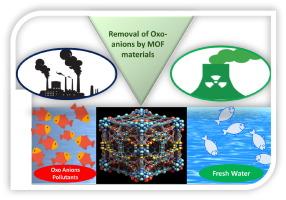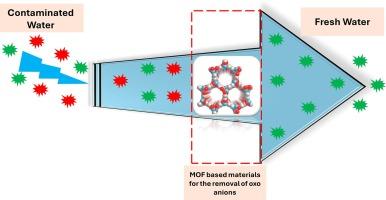Metal-Organic Frameworks (MOFs) for Oxo-Anion Removal in Wastewater Treatment: Advancements and Applications
IF 13.3
1区 工程技术
Q1 ENGINEERING, CHEMICAL
引用次数: 0
Abstract
Coordination chemistry has unveiled the significant role of metal–organic frameworks (MOFs) in materials research. Characterized by diverse porous structures formed by metal ion/cluster units and organic linkers, MOFs have gained considerable attention due to their unique coordination structure, high porosity, and extensive surface area, making them invaluable in chemical, biological, and materials science. Their exceptional chemical stability also makes MOFs promising candidates for adsorbing pollutants from wastewater. Metal oxo-anions, identified as significant pollutants by the United States Environmental Protection Agency (USEPA), require efficient water treatment solutions. Traditional methods face challenges and low selectivity, leading to incomplete removal of these substances. MOFs offer a solution through their tunable functionalities, enabling selective adsorption of hazardous oxo-anions like chromium, selenium, and arsenic. Precise engineering of MOFs by incorporating suitable functional groups and metal sites can significantly enhance their adsorption capacity and selectivity, advancing environmental remediation efforts. This comprehensive review explores the critical role of MOFs in addressing environmental challenges, especially water pollution from metal oxo-anions. It highlights innovative strategies for customizing MOF architectures and optimizing their performance for selective oxo-anion removal, contributing to a deeper understanding of MOFs’ potential in achieving environmental sustainability. Additionally, the review investigates the interactions between MOFs and toxic oxo-anions, underlying mechanisms, experimental approaches, and design principles crucial for successful MOF deployment in real-world water treatment applications. By analyzing the multifaceted role of MOFs in mitigating water pollution, this review provides valuable insights that can shape the future of sustainable water management.


在废水处理中去除氧化阴离子的金属有机框架 (MOF):进展与应用
配位化学揭示了金属有机框架(MOFs)在材料研究中的重要作用。MOFs 的特点是由金属离子/簇单元和有机连接体形成的多种多孔结构,由于其独特的配位结构、高孔隙率和大表面积,使其在化学、生物和材料科学领域具有重要价值,因而受到广泛关注。MOFs 出色的化学稳定性也使其成为吸附废水中污染物的理想候选材料。金属氧化阴离子被美国环境保护局(USEPA)确定为重要污染物,需要高效的水处理解决方案。传统方法面临的挑战是选择性低,导致无法完全去除这些物质。MOFs 具有可调功能,能够选择性地吸附铬、硒和砷等有害氧化阴离子,从而提供了一种解决方案。通过加入合适的官能团和金属位点对 MOFs 进行精确的工程设计,可以大大提高其吸附能力和选择性,从而推进环境修复工作。本综述探讨了 MOFs 在应对环境挑战,尤其是金属氧化阴离子造成的水污染方面的关键作用。综述重点介绍了定制 MOF 结构和优化其选择性去除氧化阴离子性能的创新策略,有助于深入了解 MOF 在实现环境可持续性方面的潜力。此外,该综述还研究了 MOF 与有毒氧阴离子之间的相互作用、基本机理、实验方法以及对在实际水处理应用中成功部署 MOF 至关重要的设计原则。通过分析 MOFs 在减轻水污染方面的多方面作用,本综述提供了宝贵的见解,有助于塑造可持续水管理的未来。
本文章由计算机程序翻译,如有差异,请以英文原文为准。
求助全文
约1分钟内获得全文
求助全文
来源期刊

Chemical Engineering Journal
工程技术-工程:化工
CiteScore
21.70
自引率
9.30%
发文量
6781
审稿时长
2.4 months
期刊介绍:
The Chemical Engineering Journal is an international research journal that invites contributions of original and novel fundamental research. It aims to provide an international platform for presenting original fundamental research, interpretative reviews, and discussions on new developments in chemical engineering. The journal welcomes papers that describe novel theory and its practical application, as well as those that demonstrate the transfer of techniques from other disciplines. It also welcomes reports on carefully conducted experimental work that is soundly interpreted. The main focus of the journal is on original and rigorous research results that have broad significance. The Catalysis section within the Chemical Engineering Journal focuses specifically on Experimental and Theoretical studies in the fields of heterogeneous catalysis, molecular catalysis, and biocatalysis. These studies have industrial impact on various sectors such as chemicals, energy, materials, foods, healthcare, and environmental protection.
 求助内容:
求助内容: 应助结果提醒方式:
应助结果提醒方式:


